St Abb's Head: Difference between revisions
No edit summary |
|||
| (3 intermediate revisions by 2 users not shown) | |||
| Line 1: | Line 1: | ||
{{county|Berwick}} | |||
[[File:Cliffs at St Abb's Head - geograph.org.uk - 1078752.jpg|right|thumb|300px|Cliffs at St Abb's Head]] | [[File:Cliffs at St Abb's Head - geograph.org.uk - 1078752.jpg|right|thumb|300px|Cliffs at St Abb's Head]] | ||
[[File:St_Abbs_Head_from_St_Abbs.jpg|right|thumb|200px|St Abb's Head from near St Abbs village]] | [[File:St_Abbs_Head_from_St_Abbs.jpg|right|thumb|200px|St Abb's Head from near St Abbs village]] | ||
[[File:St_Abbs_Head_from_the_NW.jpg|right|thumb|200px|The head seen from the | [[File:St_Abbs_Head_from_the_NW.jpg|right|thumb|200px|The head seen from the north-west]] | ||
'''St Abb's Head''' is a rocky promontory jutting into the [[North Sea]] by the village of [[St Abbs]] in [[Berwickshire]]. | |||
'''St | |||
The land and cliffs of the Head are a "National Nature Reserve" administered by the [[National Trust for Scotland]]. | The land and cliffs of the Head are a "National Nature Reserve" administered by the [[National Trust for Scotland]]. | ||
| Line 17: | Line 17: | ||
===National Trust for Scotland=== | ===National Trust for Scotland=== | ||
The NTS has an information point for St | The NTS has an information point for St Abb's Head located at Northfield Farm ({{map|NT913674}}), it has an exhibition with information about the Head, coffee shop, art gallery and textile shop. There are maps describing the walk to the Head and as well as Ranger led guided walks. | ||
[[File:St Abbs Visitor Centre.JPG|left|thumb|200px|St Abbs Visitor Centre]] | [[File:St Abbs Visitor Centre.JPG|left|thumb|200px|St Abbs Visitor Centre]] | ||
| Line 27: | Line 27: | ||
==Lighthouse== | ==Lighthouse== | ||
[[File:St Abb's head lighthouse.JPG|right|thumb|200px|St Abb's Head lighthouse and foghorn]] | [[File:St Abb's head lighthouse.JPG|right|thumb|200px|St Abb's Head lighthouse and foghorn]] | ||
A signal station was established on the cliffs before 1820 and the facilities were shared by Trinity House and Her Majesty's Coastguard. The Northern Lighthouse Board recommended the building of a lighthouse at St | A signal station was established on the cliffs before 1820 and the facilities were shared by Trinity House and Her Majesty's Coastguard. The Northern Lighthouse Board recommended the building of a lighthouse at St Abbs Head after the sinking of the "Martello" on Carr Rock in 1857. The lighthouse was designed and built by the brothers David Stevenson and Thomas Stevenson and assisted navigation before and after sight of the Bell Rock and [[Isle of May]] lights disappeared from view. | ||
The light began service on 24 February 1862 and initially used oil to generate its light, it was converted to incandescent | The light began service on 24 February 1862 and initially used oil to generate its light, it was converted to incandescent power in 1906 and to electricity in 1966 and finally automated in 1993. Before automation the lighthouse was staffed by three full-time keepers whose duties included keeping detailed weather records. A foghorn was established at the Head in 1876, being the first audible fog signal installed anywhere by the Commissioners for the Northern Lights. The original foghorn was driven by hot-air engines before being replaced by oil-driven ones in 1911 and then by diesel engines in December 1955. The fog signal was discontinued in 1987 although the horn is still in place and can be reached at the edge of the cliffs by a railed path from the lighthouse.<ref name="NTS"/><ref name="NLB">[http://www.nlb.org.uk/ourlights/history/stabbs.htm Northern Lighthouse Board.] Gives details of Lighthouse.</ref> | ||
Visitors can walk to the Head where the lighthouse's buildings, though still in good repair, are not open to the public. Driving is not encouraged as there is no parking when you get to the light. | Visitors can walk to the Head where the lighthouse's buildings, though still in good repair, are not open to the public. Driving is not encouraged as there is no parking when you get to the light. | ||
==Geology== | ==Geology== | ||
The layered sedimentary rocks of greywacke and siltstone which lie to the north and south of the Head were laid down at the bottom of the sea between 460 and 410 million years ago. The Head itself is made from hard volcanic rock which formed as lava flowed from volcanoes around 400 million years ago. The different type of rocks accounts for the contrast in colour between the rocks of the Head and those of mainland cliffs. The softer sedimentary rocks have eroded over time, leaving behind the high headland made from the harder rock. However even this tough volcanic rock has been affected by the actions of the sea, leaving steep gullies and sea stacks which are ideal for nesting sea birds. The harder rocks of the Head are separated from the sedimentary rock to the | The layered sedimentary rocks of greywacke and siltstone which lie to the north and south of the Head were laid down at the bottom of the sea between 460 and 410 million years ago. The Head itself is made from hard volcanic rock which formed as lava flowed from volcanoes around 400 million years ago. The different type of rocks accounts for the contrast in colour between the rocks of the Head and those of mainland cliffs. The softer sedimentary rocks have eroded over time, leaving behind the high headland made from the harder rock. However even this tough volcanic rock has been affected by the actions of the sea, leaving steep gullies and sea stacks which are ideal for nesting sea birds. The harder rocks of the Head are separated from the sedimentary rock to the south-west by the north-west-slanting St Abbs Head Fault which is marked by a low lying valley which at times of higher sea level would have been flooded, cutting off the headland from the mainland.<ref name="JNCC">[http://www.jncc.gov.uk/pdf/gcrdb/GCRsiteaccount2510.pdf Geological Conservation Review.] Gives details of geology.</ref> | ||
==History== | ==History== | ||
Just 600 yards to the | Just 600 yards to the south-east of the lighthouse is Kirk Hill. On the summit of this hill are the remains of the 7th-century monastery settlement of Saint Æbbe. About AD 643 Æbbe established the monastery on Kirk Hill within the remains of a 6th-century fort known as ''Urbs Coludi'' (Colud's Fort). Both Monks and Nuns lived at the monastery in basic beehive huts made from mud and branches. Æbbe remained as abbess until her death around 680, a few years later the monastery was accidentally burned down and was not replaced. The settlement was protected by a massive ten-foot-high turf rampart on the landward side, the remains of this rampart can be seen as a low ridge around the rim of the hill. These are the only remnants of the 7th-century monastic settlement of Æbbe. However, there are faint outlines of buildings, field boundaries and a rectangular burial site dating from the 12th century. These are the scant traces of a Benedictine chapel established in 1188 and dedicated to Æbbe by monks from Coldingham Priory. | ||
[[File:St_Abbs_village_from_St_Abbs_Head.jpg|right|thumb|200px|St Abbs from the south side of St Abb's Head]] | [[File:St_Abbs_village_from_St_Abbs_Head.jpg|right|thumb|200px|St Abbs from the south side of St Abb's Head]] | ||
| Line 43: | Line 43: | ||
==Outside links== | ==Outside links== | ||
*Location map: {{wmap|55.89978|-2.14178|zoom=13}} | |||
*[http://www.stabbs.org/ St Abbs Community Website] | *[http://www.stabbs.org/ St Abbs Community Website] | ||
*{{NT link|St Abb's Head National Nature Reserve}} | *{{NT link|St Abb's Head National Nature Reserve}} | ||
*[http://www.kbaverstock.co.uk/stabbshead.html St | *[http://www.kbaverstock.co.uk/stabbshead.html St Abb's Head panorama] | ||
*[http://www.stabbsvisitorcentre.co.uk/ The St Abbs Visitor Centre] | *[http://www.stabbsvisitorcentre.co.uk/ The St Abbs Visitor Centre] | ||
*[http://www.thegcr.org.uk/GIA/17/Figures/JPEGsHiRes/GCRv17c09f042.jpg / Aerial photograph of St | *[http://www.thegcr.org.uk/GIA/17/Figures/JPEGsHiRes/GCRv17c09f042.jpg / Aerial photograph of St Abbs Head.] | ||
*[http://www.nts.org.uk/web/site/home/visit/places/Property.asp?PropID=10024&NavPage=10024&NavId=5115 National Trust for Scotland website entry on St | *[http://www.nts.org.uk/web/site/home/visit/places/Property.asp?PropID=10024&NavPage=10024&NavId=5115 National Trust for Scotland website entry on St Abb's Head National Nature Reserve] | ||
==References== | ==References== | ||
Latest revision as of 11:34, 11 July 2017
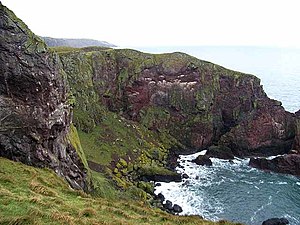
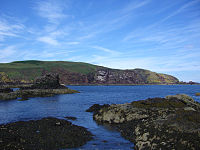
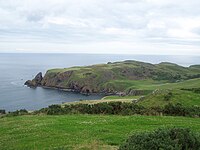
St Abb's Head is a rocky promontory jutting into the North Sea by the village of St Abbs in Berwickshire.
The land and cliffs of the Head are a "National Nature Reserve" administered by the National Trust for Scotland.
Conservation
The Nature Reserve is managed by the National Trust for Scotland in co-operation with Scottish Natural Heritage. The first part was purchased in 1980, with the Lumsdaine coastal strip being donated by Pearl Assurance Company Ltd. in 1984. Blackpotts grazings were purchased in 1994. The Head was designated a nature reserve because of its 60,000-strong seabird colony which nest on the sheer cliffs, stacks and gullies.
Kittiwakes and Guillemots are the most numerous species of the nesting birds followed by Razorbills, Shags, Herring Gulls, Fulmars and Puffins. To preserve the marine habitat, the NTS in conjunction with the Scottish Wildlife Trust, the local fishing community and diving clubs, have set up a Voluntary Marine Reserve which stretches south down the coast to the town of Eyemouth. Although best known for its seabirds, the Reserve also has flower rich grasslands and a freshwater lake.
The grazing on the Head is leased by the Trust to Northfield Farm which stands just to the south of the Head near St Abbs village.
The grassland is surprisingly rich for a coastal situation, in some places it is possible to find over 20 different species of plant in one square yard. There are at least 10 different kinds of butterfly on the Head including the northern brown argus which is a nationally rare butterfly in the United Kingdom. The butterflies drink nectar from the flowers of the wild thyme and the caterpillars eat the leaves of rock rose, the areas in which these two plants grow are protected from sheep grazing by fencing. Just inland from the lighthouse is Mire Loch, an artificial lake 600 yards long.[1]
National Trust for Scotland
The NTS has an information point for St Abb's Head located at Northfield Farm (NT913674), it has an exhibition with information about the Head, coffee shop, art gallery and textile shop. There are maps describing the walk to the Head and as well as Ranger led guided walks.
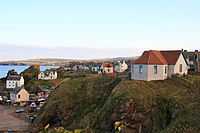
The St Abbs Visitor Centre
In March 2011 the new St Abbs Visitor Centre opened in St Abbs old village hall, perched precariously on a cliff edge. Built as a resource for both visitors and locals, the Centre offers free admission, interactive exhibits and library area with information about the headland and historical artefacts.
The position of the centre offers a stunning 180 degree view from St Abbs Head all the way to the harbour and beyond.
Lighthouse

A signal station was established on the cliffs before 1820 and the facilities were shared by Trinity House and Her Majesty's Coastguard. The Northern Lighthouse Board recommended the building of a lighthouse at St Abbs Head after the sinking of the "Martello" on Carr Rock in 1857. The lighthouse was designed and built by the brothers David Stevenson and Thomas Stevenson and assisted navigation before and after sight of the Bell Rock and Isle of May lights disappeared from view.
The light began service on 24 February 1862 and initially used oil to generate its light, it was converted to incandescent power in 1906 and to electricity in 1966 and finally automated in 1993. Before automation the lighthouse was staffed by three full-time keepers whose duties included keeping detailed weather records. A foghorn was established at the Head in 1876, being the first audible fog signal installed anywhere by the Commissioners for the Northern Lights. The original foghorn was driven by hot-air engines before being replaced by oil-driven ones in 1911 and then by diesel engines in December 1955. The fog signal was discontinued in 1987 although the horn is still in place and can be reached at the edge of the cliffs by a railed path from the lighthouse.[1][2]
Visitors can walk to the Head where the lighthouse's buildings, though still in good repair, are not open to the public. Driving is not encouraged as there is no parking when you get to the light.
Geology
The layered sedimentary rocks of greywacke and siltstone which lie to the north and south of the Head were laid down at the bottom of the sea between 460 and 410 million years ago. The Head itself is made from hard volcanic rock which formed as lava flowed from volcanoes around 400 million years ago. The different type of rocks accounts for the contrast in colour between the rocks of the Head and those of mainland cliffs. The softer sedimentary rocks have eroded over time, leaving behind the high headland made from the harder rock. However even this tough volcanic rock has been affected by the actions of the sea, leaving steep gullies and sea stacks which are ideal for nesting sea birds. The harder rocks of the Head are separated from the sedimentary rock to the south-west by the north-west-slanting St Abbs Head Fault which is marked by a low lying valley which at times of higher sea level would have been flooded, cutting off the headland from the mainland.[3]
History
Just 600 yards to the south-east of the lighthouse is Kirk Hill. On the summit of this hill are the remains of the 7th-century monastery settlement of Saint Æbbe. About AD 643 Æbbe established the monastery on Kirk Hill within the remains of a 6th-century fort known as Urbs Coludi (Colud's Fort). Both Monks and Nuns lived at the monastery in basic beehive huts made from mud and branches. Æbbe remained as abbess until her death around 680, a few years later the monastery was accidentally burned down and was not replaced. The settlement was protected by a massive ten-foot-high turf rampart on the landward side, the remains of this rampart can be seen as a low ridge around the rim of the hill. These are the only remnants of the 7th-century monastic settlement of Æbbe. However, there are faint outlines of buildings, field boundaries and a rectangular burial site dating from the 12th century. These are the scant traces of a Benedictine chapel established in 1188 and dedicated to Æbbe by monks from Coldingham Priory.
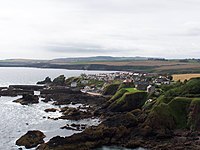
On the north side of the Head is Pettico Wick Bay this provides a natural trap for salmon as they swim down the coast. A fishing station was established here in 1880 and lasted until around 1950. A jetty was also built in the bay so supplies could be landed for the lighthouse.[4]
Outside links
- Location map: 55°53’59"N, 2°8’30"W
- St Abbs Community Website
- St Abb's Head National Nature Reserve
- St Abb's Head panorama
- The St Abbs Visitor Centre
- / Aerial photograph of St Abbs Head.
- National Trust for Scotland website entry on St Abb's Head National Nature Reserve
References
- ↑ 1.0 1.1 National Trust for Scotland Information leaflet on St. Abbs Head, Gives general information on the Head.
- ↑ Northern Lighthouse Board. Gives details of Lighthouse.
- ↑ Geological Conservation Review. Gives details of geology.
- ↑ Royal Commission Ancient and Historical Monuments of Scotland. Gives historical details of Monastery/Nunnery.